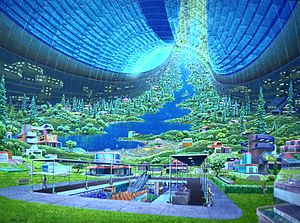From Wikipedia, the free encyclopedia
The L5 Society was founded in 1975 by Carolyn and Keith Henson to promote the space colony ideas of Gerard K. O'Neill.
The name comes from the L4 and L5 Lagrangian points in the Earth–Moon system proposed as locations for the huge rotating space habitats that O'Neill envisioned. L4 and L5 are points of stable gravitational equilibrium located along the path of the moon's orbit, 60 degrees ahead or behind it.
An object placed in orbit around L5 (or L4) will remain there indefinitely without having to expend fuel to keep its position, whereas an object placed at L1, L2 or L3 (all points of unstable equilibrium) may have to expend fuel if it drifts off the point.
Founding of L5 Society
O'Neill's first published paper on the subject, "The Colonization of Space", appeared in the magazine Physics Today in September 1974. A number of people who later became leaders of the L5 Society got their first exposure to the idea from this article. Among these were a couple from Tucson, Arizona, Carolyn and Keith Henson. The Hensons corresponded with O'Neill and were invited to present a paper on "Closed Ecosystems of High Agricultural Yield" at the 1975 Princeton Conference on Space Manufacturing Facilities, which was organized by O'Neill.[1]At this conference, O'Neill merged the Solar Power Satellite (SPS) ideas of Peter Glaser with his space habitat concepts.[2]
The Hensons incorporated the L5 Society in August 1975, and sent its first 4-page newsletter in September to a sign up list from the conference and O'Neill's mailing list.[3] The first newsletter included a letter of support from Morris Udall (then a contender for US president) and said "our clearly stated long range goal will be to disband the Society in a mass meeting at L5."[4]
Moon Treaty, decline of L5 Society and merger with National Space Institute
The peak of L5's influence was the defeat of the Moon Treaty in the US Senate in 1980 ("... L-5 took on the biggest political fight of its short life, and won").[1] Specifically, L5 Society activists campaigned for awareness of the provisions against any form of sovereignty or private property in outer space that would make space colonization impossible and the provisions against any alteration of the environment of any celestial body prohibiting terraforming. Leigh Ratiner, a Washington lawyer/lobbyist, was instrumental in this effort.[citation needed]
Although economic analysis[5] indicated the SPS/space colony concept had merit, it foundered on short political and economic horizons and the fact that the transport cost to space was about 300 times too high for individuals to fund when compared to the Plymouth Rock and Mormon colonies.[6]
In 1986, the Society, which had grown to about 10,000 members, merged with the 25,000 member National Space Institute, founded by German rocket engineer and Project Apollo program manager Wernher von Braun of NASA's Marshall Space Flight Center to form the present-day National Space Society.[7]
While the L5 Society failed to achieve the goal of human settlements in space, it served as a focal point for many of the people who later became known in fields such as nanotechnology, memetics, extropianism, cryonics, transhumanism, artificial intelligence, and tether propulsion, such as K. Eric Drexler, Robert Forward, and Hans Moravec.[8][9]




